


QUICK LINKS
Grants for Young Researchers
Publications
Congresses
Jobs and Studentships
Elections
Soil Conservation Projects
Conference Report
Biogeochemical processes
at Air-Soil-Water Interfaces and Environmental Protection
held in Imola, Riolo Terme, Ravenna (Italy) 23-26 June 2014
1. Introduction
From 23 to 26 June 2014, the Department of Agricultural Sciences of Alma Mater Studiorum-University of Bologna hosted the ESSC international conference “Biogeochemical processes at Air-Soil-Water Interfaces and Environmental Protection” (ASWEP) in Imola, Riolo Terme and Ravenna (Italy).
The Congress was attended by about 100 scientists from 25 countries of Europe, America and Asia to discuss the new advancements and challenges of soil science and the impact of the processes at air-soil-water interfaces on the environmental equilibria and on human health and well-being.
In the course of the Opening Ceremony several distinguished delegates delivered their opening speeches. These include Gian Luca Galletti (Italian Minister of Environment), the local authority Davide Tronconi (the Imola assessor for urban development planning), Sergio Santi (President of the Fondazione Cassa di Risparmio di Imola) Carmelo Dazzi (President of the European Society for Soil Conservation) and Gilmo Vianello (President of the Organizing Committee).
The Conference was supported by the European Commission and international scientific societies (International Union of Soil Sciences – IUSS, International Soil Conservation Organization – ISCO, World Association of Soil and Water Conservation – WASWC, European Confederation of Soil Science Societies – ECSSS, European Commission-Joint Research Centre - EC-JRC) as well as national scientific societies and research institute (Società Italiana della Scienza del Suolo – SISS, Società Italiana di Pedologia – SIPE, Consiglio per la Ricerca e la Sperimentazione in Agricoltura - CRA) and some private agencies working in environmental area (Prati Armati, Ambios s.r.l., BioAlgae, Agroverd, Ecosearch). A special contribution was given by Geolab onlus (Imola) which took over most of the obligations of the organization of the Conference.
The main themes and subjects, that have been presented and discussed by the 4 invited lectures, the 30 oral presentations, the high number of posters presented in the thematic sessions and during the scientific excursion, are summarized in this report.
More information and a comprehensive programme of the Conference can be found at: http://aswep-essc.unibo.it/index.php
2. The scientific programme
The Conference consisted of four main sessions, each of which had a topic concerning the biogeochemical cycles in soil sciences, summarized in Concepts, Factors, Processes and Techniques and introduced by renowned experts in the fields.
The scientific contributions were held by experienced scientists as well as young PhD candidates or researchers which actively enriched the well-balanced program of the Conference.
The Factors session was introduced by Prof. Markus Egli (photo 1) from the University of Zurich, who gave a talk about how to determine soil production and erosion rates in mountain areas. In this session, particular interest was mainly devoted to the problem of both geogenic and anthropogenic soil pollution by different sources, such as heavy metals and emerging pollutants. Moreover, it was highlighted how the functionality of soil can be affected by extreme environmental conditions.
The Concept section was presented by Prof. Paolo Nannipieri (photo 2) from the University of Florence, who discussed the importance of the biological system for understanding and investigating the soil functionality, and overviewed the most advanced techniques in the omics research. Several approaches applied to the study of nutrient fluxes in soil-water interfaces were discussed in this session, highlighting the importance of modeling, as well as bench-scale and field experimentations for a better comprehension of geochemical fluxes of nutrients.
Prof. Eleonora Bonifacio from the University of Torino (photo 3) introduced the third session, Processes. She overviewed the pedogenetic processes linked to the organic matter stabilization. One important topic discussed in this session regarded the processes through which contaminants in soil can be mobilized/stabilized by organic matter or by plants, including some interesting examples of phytoremediation techniques. Another relevant discussion regarded the processes of gas emission in wetlands and saturated soils and their effects on soil functionality.
Finally, for the session Techniques, Prof. Christoph Külls (photo 4) from the University of Freiburg proposed a new method for the application of isotope techniques to monitor water and carbon dioxide fluxes in soil unsaturated zones. During this session most of dissertations regarded the use of different models to assess the effect of vegetation on soil stability.
The Conference was implemented by a considerable poster session and the organizers awarded the best poster of each scientific area. The winners were: “Effects of the GAEC cross compliance standard “management of set – aside” on soil biodiversity in Italy” by S. Mocali, S. Landi, A. Fabiani, G. d’Errico, R. Piccolo, P. Bazzoffi for the Factors session; “Humic acid properties in the oligotrophic bog of west Siberia” by M. V. Zykova, E.E. Veretennikova for the Concept session; “Rhizosphere effect on a soil derived from limestone in a thousand – year – old holm oak (Quercus ilex L.) forest” by A. Agnelli, L. Massaccesi, M. De Feudis, V. Cardelli, S. Cocco, G. Corti for Processes session; “Understanding the carbon isotopic signature in complex environmental matrices” by C.Natali, G.Bianchini for Techniques session.
For an overview of the abstracts, either of presentations or poster sessions, use the above mentioned link of the Conference.
The ESSC provided 2 grants to support the participation of young researchers to the Conference. During the Conference, Obiageli Obua (working at the University of Wolverhampton, West Midlands, UK) and María Pilar Serrano Muela (working at the Superior Council of Scientific Research, Zaragoza, Spain) were awarded the ESSC grant by the ESSC grant Commission (photo 5).
The post-Conference excursion led to the San Vitale Pinewood located in lowlands of Adriatic coast, northward of Ravenna. The area is soaked with human-nature interactions and is characterized by variable morphology and habitats, even if it has a limited extension. Thus, it is a suitable location for the understanding of biogeochemical processes in a particularly diverse environment, and it has attracted the interest of many researchers during time. The group of the University of Bologna showed tree soil profiles, one of which is included in the newest class of soils in the Soil Taxonomy classification system (USDA): the subaqueous soils. Moreover, during the field trip Prof. David Weindorf (USA) had the opportunity to perform XRF infield-analysis on one of the soil profiles (photo 6) with a modern portable instrument (DELTA Mining and Geochemistry Handheld XRF Analyzer, Olympus).
At the end of the Conference the Prof. Carmelo Dazzi read the ASWEP-ESSC International Conference resolution, which has been approved unanimously by the participants. The agreed text is reported in Chapter 4.
3. The social programme
The excursion to the natural park “Vena del Gesso”, on the second day of the conference, transported the participants through stunning landscapes and extremely peculiar environments. With the help of local guides, the group went through natural aspects and historical events of the area. The park is sprinkled of natural caves and tunnels dug in the Gessoso-Solfifera Formation (Upper Miocene), which have been used from the very beginning of the human history for different purposes. After the visit of the Grotta del Re Tiberio, the social dinner was held in Riolo Terme and the Roaring Emily Jazz Band enlivened the evening.
On the third day, the participants to the Confence have experienced the evocative voice of the Stelutis Choir. Ballads, work songs and lullabies from the Emilian peasantry tradition were performed in a touching cappella style.
4. Final resolution ASWEP – ESSC
RESOLUTION OF THE ASWEP – ESSC INTERNATIONAL CONFERENCE
Biogeochemical Processes at Air-Soil-Water Interfaces and Environmental Protection
IMOLA (ITALY), 23 – 26 JUNE 2014
The ASWEP – ESSC International Conference on “Biogeochemical Processes at Air-Soil-Water Interfaces and Environmental Protection” involving about 100 participants from 25 countries, representing national and international societies of soil science, research agencies, universities, government bodies, higher education, science, public non-governmental organizations, and business,
hearing
the results of the invited lectures, the 30 oral presentations and of the several posters presented from the thematic sessions,
identified
that the level of degradation of the natural resources, and particularly soils, related to the pressure of man, is becoming more and more evident in many areas of the world;
considering
the importance of the multi-functionality of soils and of the impact of the processes at Air-Soil-Water Interfaces on the environmental equilibria and on human health and welfare all over the world;
the REFIT communication from the European Commission on the withdrawing of the “Thematic Strategy for Soil Protection”;
request
that decision makers, land managers and administrators:
ensure application of sound environmental management technologies for soil, air, water protection so as to ensure a healthy environment for present and future generations;
recognize the importance of high quality soils for agriculture and the environment and to protect this valuable resource from degradation and consumption;
apply soil information and scientific knowledge more effectively in order to protect and safeguard the ecological and life support capacity of soils;
maintain the Soil Framework Directive;
stress
the importance of the natural resources in maintaining and safeguarding the environment equilibria for human health and well-being.
and recommend all Governments and Institutions
to develop environmental policies aimed to favor the maintenance and improvement of soil functions such as biomass production, storing, filtering, and transforming nutrients and water, hosting the biodiversity pool, acting as a platform, acting as a carbon pool and mitigating climate change, and geological and cultural heritage.
to pay particular attention to maintain and re-establish the peculiar function of soils to produce goods and services of quality and quantity when damaged;
to pay particular attention to maintain and to re-establish a correct equilibria in the air-soil-water interface processes that influence all living systems and the quality of life.
Serena Carbone
Chiara Ferronato
Marco Natale
Department of Agricultural Sciences
Alma Mater Studiorum – University of Bologna
Italy
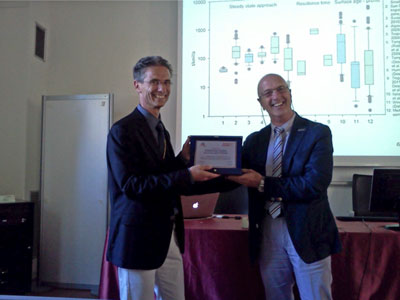
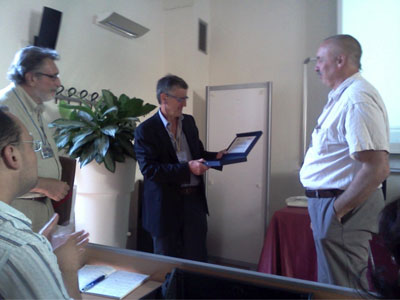
Photo 1 – Marku Egli is awarded by Carmelo Dazzi for his key note presentation
Photo 3 – Eleonora Bonifacio is awarded by Gilmo Vianello for his keynote presentation
Photo 5 – María Pilar Serrano Muela with Carmelo Dazzi and Edoardo Costantini
Photo 2 – Paolo Nannipieri is awarded by Giuseppe Corti for his keynote presentation
Photo 4 – Christoph Külls is awarded by Adam Kertesz for his key note presentation
Photo 6 – David Weindorf performing XRF infield-analysis on one of the soil profiles showing during the field trip
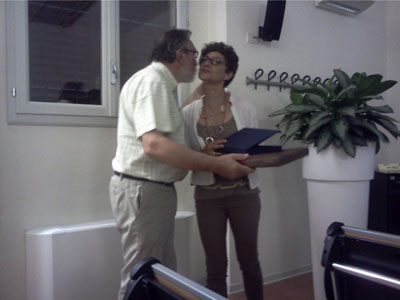
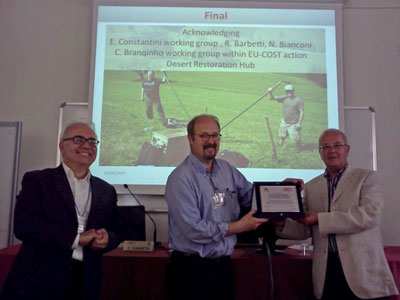
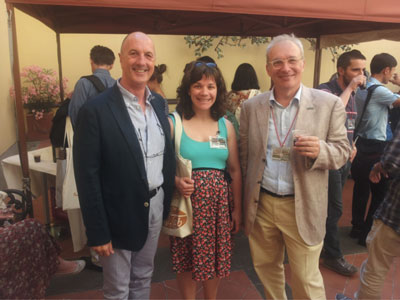
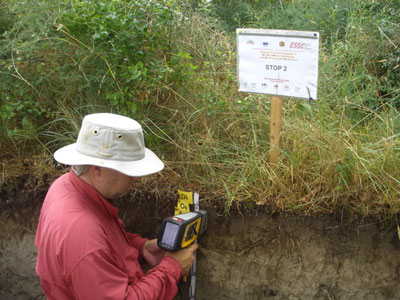
NEWS
Scientific and Cultural Days of Imola – 17th year, Italy
Global Soil Conference 2024, New Delhi, India
GM5.5 Geodiversity and geoheritage, Vienna, Austria
5th International Conference SCSI, India
5th WASWAC World Conference, Olomouc, Czech Republic – added link
Centennial of the IUSS, Florence, Italy
Thought for the month
“Planet Earth has no tourists”
(Richard Templar, 2006).
©2014 European Society for Soil Conservation. The owner of the content of this website is the European Society
for Soil Conservation (ESSC) and can only be used with the consent of the owner of this website or members of the ESSC.